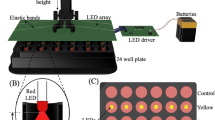Abstract
The glass transmission block, a key component of all intense pulsed light (IPL) devices, is responsible for the delivery of IPL energy from the xenon discharge lamp to hair and skin structures during treatment. The purpose of this study was to investigate the variation in temperature of the quartz glass block used in the iPulse™ (CyDen, Swansea, UK) handset during typical hair removal treatments of Asian and Afro-Caribbean skin types. Initial results from four subjects indicated that the temperature of the glass transmission block did not exceed 45°C during any of the treatments. Furthermore, the development of the temperature measurement methodology described in this paper will enable the comparison of data from different IPL systems to be undertaken in a subsequent larger scale trial.





Similar content being viewed by others
References
Thiagalingam et al (2005) A thermochromic dispersive electrode can measure the underlying skin temperature and prevent burns during radiofrequency ablation. J Cardiovasc Electrophysiol 7:781–788
Steinke K, Gananadha S, King J, Zhao J, Morris DL (2003) Dispersive pad site burns with modern radio frequency ablation equipment. Surg Laporosc Endosc Percutan Tech 13:366–371
Aigner N, Fialka C, Fritz A, Wruhs O, Zoch G (1997) Complications in the use of diathermy. Burns 23:256–264
Neufeld GR, Foster KR (1985) Electrical impedance properties of the body and the problem of alternate-site burns during electrosurgery. Med Instrum 19:83–87
Goldman MP, Eckhouse S (1996) Photothermal sclerosis of leg veins. ESC Medical Systems, PhotoDerm VL Cooperative Study Group. Dermatol Surg 22:323–330
Miyake RK, Miyake H, Kauffman P (2001) Skin temperature measurements during intense pulsed light emission. Dermatol Surg 27:549–554
Weiss RA, Weiss MA (2001) Noncoherent filtered flashlamp intense pulsed light device. In: Lyons K (ed) Lasers in aesthetic surgery. Thieme, New York, p 196
Dewhirst MW, Viglianti BL, Lora-Michiels M, Hanson M, Hoopes PJ (2003) Basic principles of thermal dosimetry and thermal thresholds of tissue damage from hyperthermia. Int J Hyperthermia 19(3):267–294
Moritz A, Henriques F (1947) Studies of thermal injury II. The relative importance of time and surface temperature in the causation of thermal burns. Am J Pathol 23:695–720
Author information
Authors and Affiliations
Corresponding author
Rights and permissions
About this article
Cite this article
Ash, C., Town, G.A. & Martin, G.R. Preliminary trial to investigate temperature of the iPulse™ intense pulsed light (IPL) glass transmission block during treatment of Fitzpatrick II, IV, V, and VI skin types. Lasers Med Sci 22, 4–9 (2007). https://doi.org/10.1007/s10103-006-0417-7
Received:
Accepted:
Published:
Issue Date:
DOI: https://doi.org/10.1007/s10103-006-0417-7




